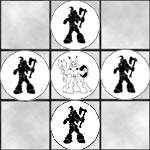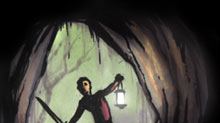Tablut
A traditional Viking game
This edition by Demian Katz, with art by Jode Carrasco
Download the Game Pieces now!
Summary
This
game, popular among Vikings, simulates a clash between two armies.
One, the white force, is attempting to escort their King to freedom.
The black force, on the other hand, is attempting to prevent this
escape.
Pieces
move like the Rook in Chess: any number of spaces in a straight
line horizontally or vertically. All pieces behave in the same manner,
except that only the king is allowed to end movement on the shaded
spaces in the center and at the corners of the board.
A piece
is captured whenever it is surrounded on two opposite horizontal
or vertical sides. A piece can be surrounded either by two pieces
or by one piece and a shaded board space. The King may only be captured
if he is completely surrounded, either by four enemy soldiers or
by three soldiers and a board edge or shaded square.
For
the white player to win, he or she must move the King onto one of
the shaded corner spaces, thus ensuring escape. The black player
wins if the white King is captured.
Components
The
game is played with the following components:
1
nine-by-nine game board, with shaded squares at the center and corners.
1 white King
8 white soldiers
16 black soldiers
All
of these components are provided in OgreCave's
Tablut Pieces file, which can be viewed and printed using Adobe's
Acrobat
Reader software.
Setup
At
the start of the game, the board is set up with the white King on
the throne in the center, surrounded by his men in a cross-like
formation. The black soldiers begin the game in four T-formations,
one at each side of the board.

Movement
1.
The white player moves first.
2.
Each turn, the current player may move any one piece any number
of spaces in a straight horizontal or vertical line.
3.
Pieces may not move through one another.
4.
No piece other than the King may end its move on a shaded square,
but any piece may move through a shaded square.
Capture
1.
A piece is captured when it is surrounded on two opposite horizontal
or vertical sides.
2.
A piece may be "surrounded" either by two enemy soldiers
or by one enemy soldier and a shaded square.
3.
Multiple captures may be made on a single turn if multiple enemy
pieces are surrounded as the result of a single move.
4.
The King is special; he may only be captured by being completely
surrounded, either by four enemy soldiers or by three soldiers and
a shaded square or board edge.
5.
Pieces may not be captured on their own turn; for example, on the
white player's turn, a white piece may move between two black pieces
without being harmed.
Examples:
 |
 |
This
white piece is captured, caught between two black soldiers.
|
This
black piece is captured, caught between a white soldier and
a shaded square.
|

|

|
|
This black piece is safe since it isn't surrounded horizontally
or vertically.
|
This King is defeated, and the black player is victorious!
|
Ending
the Game
1.
Whenever the white King has a clear path to a shaded corner square,
the white player must announce this fact to the black player; this
is equivalent to saying "Check!" in Chess.
2.
The white player wins when the white King lands on a shaded corner
square.
3.
The black player wins when the white King is captured.
Variants
Being
a traditional game, Tablut has many variants. Here are a few variations
you may wish to try:
1.
The King may be captured just like any other piece except when
on or adjacent to his throne (the central shaded square), at which
point it takes four men (or three men and the throne) to manage
a capture.
2.
Pieces may be captured against the edge of the board; that is,
a piece on a square on the outer edge of the board may be captured
by a single enemy soldier.
3.
Pieces other than the King may land on corner squares.
Bibliography
"Rules
for Medieval Games." Tara Hill Designs. 20 March 2001.
Online. Available:
http://www.tarahill.com/instruct.html
"Rules
of Tablut." Sir Robin Defends the Mystical Druids of Dover!.
20 March 2001. Online. Available:
http://www.stmoroky.com/games/tablut/tabrules.htm
"Tablut
Rules." Expo Media AB. 20 March 2001. Online. Available:
http://www.expomedia.se/tablut/eng/object.htm
|




